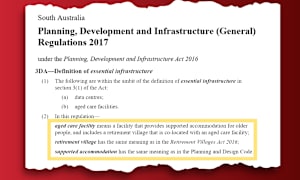Is this why we are not hearing more about operators walking away from the sector – as forecast by Gary Barnier?
The Australian is reporting that the Department of Health has allocated at least $564,000 since last November to keep open the doors of the 40-bed DP Jones aged care home in Murchison, 167km from Melbourne – despite the home having no residents or staff since early this year.
As we covered here, residents were relocated and staff made redundant in February after two expressions of interest campaigns by the administrator failed to net a buyer for the facility which had debts of between $3 and $4 million.
The newspaper says the funding for the home – which is in the electorate of Nationals MP Damian Drum – is now expected to continue for up to six months ahead of its reopening under a new operator with negotiations underway for a takeover.
Mr Drum told The Australian that the funding was needed to ensure regional Australians had the same access to care as capital city residents.
“The funding we have put in to this nursing home so far has been necessary because once it went into administration, the federal government no longer had total control of its operation,” he stated.
Aged Care Minister Senator Richard Colbeck also issued a statement through a spokesperson to say that the Government had asked the liquidator SV Partners not to sell the home during the COVID pandemic.
“This was in order to explore every opportunity for the facility to reopen in order to deliver aged-care services to the community of Murchison,” the spokesperson said.
We spoke to the liquidator about the home. Their spokesperson said that the funding is designed to keep the home “fit for purpose” while the search for a buyer continues.
They acknowledged the home has always run below capacity and the difficulty of trying to find a new operator for a very small, regional facility.
“The Government wants to see all Australians care for appropriately,” they said. “It’s a waiting game now.”
It may be a wasted effort however.
Historically, facilities with 40 beds or fewer struggle to remain financially viable.
StewartBrown’s Grant Corderoy told the Royal Commission’s recent funding and financing hearing that the largest operating losses in residential care are in facilities with less than 40 beds or over 120 beds – because they are the most inefficient.
Will a new operator be able to overcome these challenges – and is it worth it if there are no residents left?









